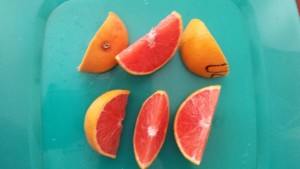Citrus Showcase: A Very Informal Varietal Tasting
While walking the trade show floor at California Citrus Mutual’s Annual Citrus Showcase, held each March at the Visalia Convention Center, I stopped by the Citrus Research Board’s booth.
The staffers, who were extremely helpful and friendly, asked if I wanted to take home some samples of the many varieties they had on display. They even offered me a Sharpie to mark each fruit to indicate the variety. I brought the fruit home, and conducted tastings over the next few days with my fruit-loving (as might be expected) teenage son, Jack.
What follows is a list of the varieties we sampled, along with some information on each variety, as well as brief tasting notes. I thought you might be interested in what a couple of typical consumers — a Millennial and a Baby Boomer — think.

Variegated Cara Cara navel orange was a hit, but alas, it was the only variety in the tasting not commercially available. (Photo Credit: David Eddy)
All the varieties below are commercially available in California through the Citrus Clonal Protection Program except the variegated Cara Cara navel orange. For more information on each, as well as on numerous other citrus varieties, check out the website of the University of California-Riverside Citrus Variety Collection.
Tarocco #7 blood orange
Source: Received as budwood from a seedling from CRC #2796, produced at CRC, 1967.
Parentage/Origins: Tarocco blood orange was introduced from an unknown Mediterranean country to Florida about 1880 and brought to California soon after.
Season of ripeness at Riverside: December to February
Tasting Notes: “Really good, distinctive flavor, perhaps notes of apricot.”
Smith Red blood orange
Source: Received as seed from a homeowner (Smith) of Moorpark, Ventura County, CA, 1988. Smith Red blood orange was received from the UCR Variety Collection in 1998. The first budwood went out to nurseries in 2004.
Parentage/origins: Merleen Smith residence, Moorpark, CA, c. 1988. Released by California Citrus Clonal Protection Program in 2004. Originally believed to be a spontaneous mutation of backyard Valencia tree and named ‘Smith Red Valencia’, but this parentage seems unlikely.
Season of ripeness at Riverside: January to April
Tasting Notes: “A shirt stainer, the red/pink juice spurts out when cut. … Fair number of seeds, though.”
Cara Cara navel orange
Source: Received as budwood from Florida (originally came to Florida, Budwood Registration Program, Winterhaven, from Venezuela), 1988.
Parentage/origins: Cara Cara navel orange, a mutation that occurred on a Washington navel orange tree, was discovered in 1976 at Hacienda Cara Cara in Venezuela. From Venezuela, it was brought to Florida and then introduced into California, where it is well adapted.
Season of ripeness at Riverside: November to January
Tasting Notes: “Extremely aromatic. … Pink flesh had exotic look”
Variegated Cara Cara navel orange
Source: Received as budwood from a normal Cara Cara navel orange tree in the Citrus Variety Collection, 2006.
Parentage/origins: A bud mutation on a branch of a normal Cara Cara navel orange.
Season of ripeness at Riverside: December to January
Tasting Notes: “Super pink. … Delicious sweet/tart flavor.”
Moro blood orange
Source: Received as budwood from USDCS, Indio, CA, via CCPP, 1975.
Parentage/origins: Parents unknown
Season of ripeness at Riverside: December to February
Tasting Notes: “As the name states, not just red, but blood red. Not too sweet, so it would work in a salad or paired with something sweet like vanilla ice cream.”
Emerald mandarin
Source: Received as budwood from 2 PH Farms, Queensland, Australia, 2003.
Parentage/origins: Parents unknown.
Season of ripeness at Riverside: October to December
Tasting Notes: “Very sweet. … Nice, small-medium size … But super-seedy.”
Tango mandarin
Source: Received as a live tree from the UCR Breeding Program, 2007.
Parentage/origins: Tango is the result of a mutation induced by irradiating budwood of W. Murcott Afourer mandarin.
Season of ripeness at Riverside: February to April.
Tasting Notes: “Not super sweet, but excellent citrus flavor. … Just a single seed.”
Gold Nugget mandarin
Source: Received as budwood from J.W. Cameron, date unknown.
Parentage/origins: Wilking mandarin x Kincy mandarin
Season of ripeness at Riverside: February to June
Tasting Notes: “Outstanding flavor. … Sweetest of the bunch. … Zero seeds.” ●









